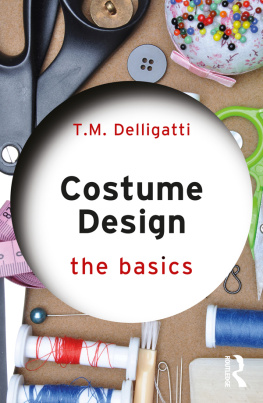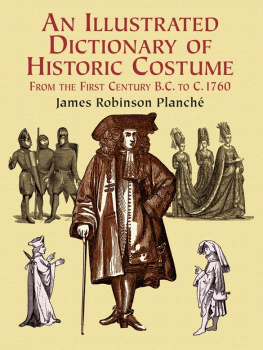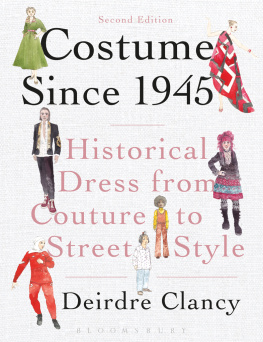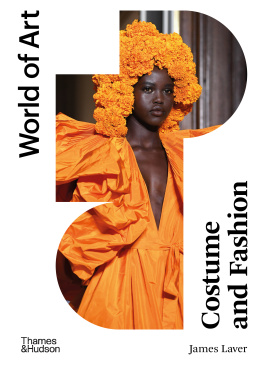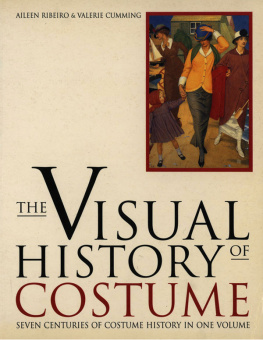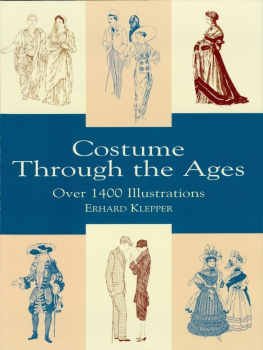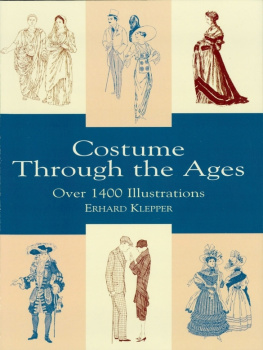Fashion in Costume
1200~2000

Fashion in Costume
1200~2000
SECOND EDITION
Joan Nunn

This edition first published in the USA in 2000 by New Amsterdam Books
For information, address:
New Amsterdam Books, c/o Ivan R. Dee, Publisher,
1332 North Halsted Street, Chicago 60622.
ISBN 1-56663-279-X
1984, 2000 Joan Nunn
This edition originally published by The Herbert Press
an imprint of A & C Black (Publishers) Limited
35 Bedford Row, London WC1R 4JH
All rights reserved, including the right to reproduce
this book or portions thereof in any form.
Manufactured in the United States of America
and printed on acid-free paper.
Library of Congress Cataloging-in-Publication Data
Nunn, Joan.
Fashion in costume, 12002000 / Joan Nunn.
p. cm.
Includes bibliographical references and index.
ISBN 978-1-56663-279-9
1. CostumeHistory. 2. FashionHistory. 3. CostumeEuropeHistory.
4. FashionEuropeHistory. I. Title.
GT580 .N85 2000
391'.009dc21
99-047516
Contents
To my brother John
and to the memory of my parents
Charles and Lilian
Acknowledgements
I would like to thank the staff of the libraries at the University of Kent at Canterbury, the Canterbury College of Art, the Kent County Library, the Museum of London, the Victoria and Albert Museum, and the research department of the Museum of Costume, Bath, for their help. Thanks are also due to Mrs Sidney Jowers for her research on my behalf in the USA, Miss Enid Billings for typing the manuscript, Mr George Maynard for the calligraphy on the illustrations, and Mrs Brenda Herbert for her kindness, patience and understanding as editor. Finally, I would like to thank Waveney Payne and Elizabeth Baker for research on my behalf for this second edition, and Tesni Hollands and Katie Taylor for their editorial advice.
I would also like to pay tribute to the late Janet Arnold, whose outstanding research on the cut and construction of clothes from the past improved greatly the making of period costumes for stage, and particularly for film and television.
Introduction
Mans inventiveness in manipulating a length of cloth into a three-dimensional shape to cover the human body has been demonstrated with astonishing variety over the past eight centuries. The continuous desire for change in dress cannot be dismissed as arbitrary. Fashion, whether in art, architecture, furniture or dress, must rather be seen as the expression of ideas shared by a number of people at any one time, often linked to fundamental changes in moral or social values, and thus reflecting the essential characteristics of a particular period; and dress as an art form, a skilful arrangement of materials through which ideas or messages, both personal and social, are communicated.
Articles of clothing were first used in this way as symbols of rank, authority or occupation, a function that still survives in, for example, a kings crown, a bishops mitre and cope, special robes for judges or men of learning, and uniforms for military or specialized services. From these specific symbols developed the use of clothes to convey less obvious or direct messages such as the superiority of one individual over another, particularly in terms of wealth (which frequently also meant power), indicated by jewels, rich fabrics and furs, or garments in which it would be difficult to undertake physical labour. Even today clothes indicating financial success may be desired.
The need to achieve status and win admiration is a fundamental human instinct and is reflected in our clothing. Few people are completely indifferent to the clothes they wear; even those who choose to dress out of fashion in what they consider a more aesthetic manner or one that is negligent or even slovenly often achieve a sense of superiority in being unconventional. But there is also a strong urge to belong; man is a social animal and needs to feel at one with the community. Fashion, particularly in the highly personal area of dress, is therefore an expression of the communal ideas or beliefs of a social group as, for example, in the revolutionary casting-off of formality in the late 18th and early 19th centuries, the restrictive, often hypocritical formality of much of the Victorian period, the greater emancipation of women during the mid 1920s, and the deification of youth and revolt against the establishment in the 1960s.
The desire to be admired for physical beauty also plays an important part in costume. In seeking to achieve the ideal fashionable image, dress has been used to accentuate good points and disguise shortcomings. Success in attracting the opposite sex has been consistently admired and envied, but physical ideals have varied widely, noticeably rather more so for women than men during the 19th and 20th centuries.
Why should men and women dress differently? The assumption since the mid 16th century that skirts are correct for women and not for men (except in certain specialized dress such as the Scottish kilt) was fairly obviously brought about by roles they were called upon to play in society, underlined by religious pressures. Feminists may claim that masculine desire for superiority or dominance caused women to be dressed in garments that hampered their movements; but it may be that such garments were originally an indication of a ladys privileged position. However, most upper and middle class women, forced until comparatively recently to accept marriage as the only respectable career, had for practical reasons to look for social advancement or financial stability in a husband if they had any choice at all, while men, who had greater freedom, might be attracted into marriage by beauty alone; and this may have encouraged what has been referred to as the erotic or seduction principle in womens dress, with a constant change of emphasis on different parts of the anatomy to stimulate interest and attention. With less religious pressure and greater equality between the sexes in the last few decades, men and women have often worn similar clothes, so whether differentiation of the sexes by clothing will continue in the future is open to conjecture. I personally think that womens dress, like mens since the 19th century, will tend to change less dramatically and remain fairly practical; but on suitable occasions lavishly trailing skirts or robes in rich fabrics may still have a place, and perhaps convention and custom will alter to allow men also to wear such garments once again.
The study of fashion and costume is fascinating not only for the artistry and skilled craftsmanship it reveals but also for the many queries posed by the messages contained in dress. It requires careful observation of the construction and manufacture of original period garments whenever possible, and also of contemporary portraits, sculpture, prints and photographs to note how garments were worn. Also essential for an understanding of the exterior image is a knowledge of the corset or underwear worn beneath the outer garments; many theatrical period costumes have proved unsatisfactory because this has been overlooked. I have therefore indicated, where space allows, how garments were made and how they were supported; and for the illustrations I have in every case worked from contemporary sources to endeavour to catch a little of the spirit of the age. From the 13th to the early 19th century there were often marked differences between the clothes worn in different countries; later fashion became more international. The illustrations therefore show the country of origin until
Next page

